
Strands of sun-dried grass, loosely spun, can be woven into a covering for a camp bed if you are without blankets. When weaving for this purpose, make sure that the warp strands are pushed closely up to each other. Do not try and make a camp blanket too heavy. It is better to make two light grass coverings than one heavy one . . . it is a number of layers, rather than extreme thickness of one layer, which keeps you warm.
WEAVING A CAMP HAMMOCK
Normally a hammock is made by using the netting tie, and netting needle (not shown in this book), but a serviceable hammock can be woven on the camp loom from bush materials. The ball of warp is passed around the weft threads to form an overhand knot on the lower lay of the weft, and these knots, pulled tight, make the weaving secure.
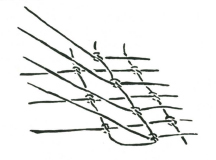
BUSH LADDER

A bush ladder is easily made. Select two long, straight poles cut to equal length. Lash the thin ends together. Spread the butts or thick ends so that they are about two and a half to three feet apart. To these lash the rungs, and make certain that the lashings are good and tight. Lashing the rungs is made easier if you lift the butts on to a log or a couple of big stones. This will allow you to pass the lashing material more easily under the poles.
SINGLE ROPE LADDER

Cut as many hardwood chocks, 1½ to 2 inches thick, as you require for your ladder. These are placed every fifteen to eighteen inches apart. The chocks should be about four inches across and can be cut from either square or round timber. Bore a hole through the centre of each chock. This hole should not be more than one-eighth inch larger than the diameter of the rope.
Thread the rope through the holes in the chocks and then, starting at one end, open the strand of the rope and slip in a half-inch thick hardwood peg about three inches long. Bind the rope below the peg. Slide the chock down, and measure off the distance to the next step. If desired, bind above the chock to prevent the feet pulling it up when climbing.
If using braided cotton rope omit
SWINGING SHELTER
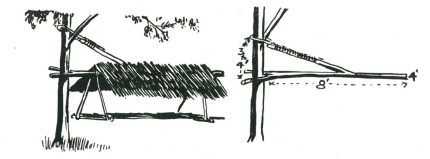
A forked pole, at least four to five inches thick, and eight feet long, with a side branch coming off at right angles to the fork and four to five feet below it, is required. To the side branch a rope or very strong vine loop is secured, passed around a tree trunk, and then bound very securely back on to the side branch. The long arm of the pole should be horizontal and six to seven feet above the ground.
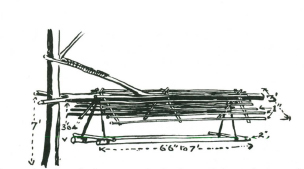
To make the shelter top, lash three 3-ft. stakes, each about 2 inches thick, to each side of the pole. They should slope down at an angle of about forty-five degrees, and can be held outwards by lashing braces across.
Lengthways to these poles lash thatching battens, each about 1 inch thick and eight feet long. These should be six inches apart. They are then thatched with grass, fern palms or reeds. (Branches and tree leaves are useless.)
The bed is suspended from the centre pole by ropes or vines to the two long sides, which are held apart by lashing two cross-bars at head and foot. The bed is then made up like the camp bed.
This shelter can be swung round the tree trunk to take advantage of sun or shade or get better protection from the weather.
SLUSH LAMP

A lamp for your camp is made by filling an old tin or small hollow piece of branch with clayey earth, packed tight at the bottom. The earth should come to about an inch from the top of the tin. Into this a twig is pushed and a piece of old cotton rag, or very finely teased bark fibre, is wound round the twig to serve as a wick. Fat from your cooking is poured on top of the earth, and when the wick is lit the lamp burns with a clear flame. The amount of light can be controlled by the size of wick.
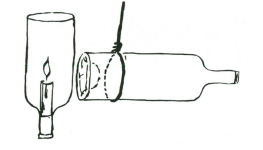
A CANDLE HOLDER FROM A BOTTLE
An open flame in a tent is dangerous, and a candle holder or glass cover for a slush lamp can be made by cutting off the base of a clear glass bottle. A very easy way to cut the glass cleanly is to heat a piece of thin wire to red heat. Bend this around the bottle where you want to cut it (alternatively, tie a piece of grease-soaked string round the bottle and burn it), and then, when the hot wire or burning string is around the bottle, immerse the bottle in cold water. The glass will break off evenly at the place where the wire or string encircled it.
NOGGIN

On many trees you will see lumpy growths or “burls”, varying in size from a few inches to a foot or more. These are covered completely over with bark, and if you examine one closely you will find that under the bark the wood is all solid, and the growth is complete, without any holes where branches might have once grown.
Cut off the lump by making a scarf an inch or so above and another below the growth. A side-cut with your axe will then slice the wood with the burl completely free. Roughly trim the surplus wood, and with a gouge clean out the wood from the centre of the burl. This is very easy, because the grain follows the curves of the growth. Leave a handle in the form of a lip, and if you so wish, bore a hole through this handle and put a leather loop through the hole. A coconut shell makes an excellent noggin.
CLOTHES PEGS
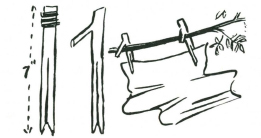
Clothes pegs are quickly made by taking a number of half-green sticks, about seven inches long, and splitting them, first binding the end so that they will not split right along their length. A better way is to use a forked stick, hooking the hook part on to a branch.
CAMP BROOM
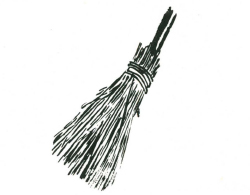
A bundle of green straight sticks, each not much thicker than a matchstick, is collected and bound tightly to a central handle. The business end of the broom is then trimmed off.
BUSH HOE
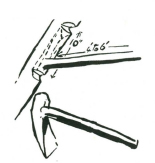
Select a dead or half-dead branch of hardwood, four to six inches thick, with a side branch from five to six feet long and an inch and a half thick coming off it at a fairly wide angle. Trim the side branch so that it is smooth. With your machete or tomahawk, trim the main branch so that it is a “hook” to the handle part. See that it is sharpened to a chisel edge. This bush hoe is quite an efficient digging tool, particularly if the digging end is fire hardened.
BUSH SLED
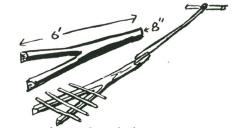
There are occasions when it is necessary to move a heavy load, and for this purpose a bush sled can be easily made from a forked branch of a tree. The branch is cut with the prongs of the fork a couple of feet behind the end of the main branch. A rope or other means of towing the sled is fastened on to this main part of the branch, and across the forks a few straight sticks are laid, and the load placed on top of these.
CAMP LARDER